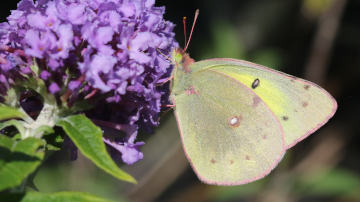Village News

PHOTO COURTESY OF GARRY KESSLER
Close-up of a clouded sulphur butterfly
September 24, 2021
NATURE NOTES
By Annie Reid
Westborough Community Land Trust
Where are all the butterflies?
Where are all the butterflies? That’s what many of us have been wondering this summer, with butterflies surprisingly scarce in local fields and gardens. Even so, you’ve probably seen monarchs this September, and noticed them flying southward. The last monarch generation of the summer is setting out on its storied journey to Mexico. In addition to the departing monarchs, one butterfly that you’re likely to see, even into November, is the small yellow butterfly known as a clouded sulphur.
Clouded sulphurs (Colias philodice) are hardy butterflies that typically fly April to November, with about three generations in that period. They don’t migrate. They’re usually common and widespread and easy to take for granted. This year, a clouded sulphur can be a very welcome sight.
Clouded sulphurs are medium-sized, with a wing span of almost two inches. They usually appear lemon-yellow from a distance. If you get a good close look when one lands nearby with wings closed, you’ll see pink edging on its wings, and you might notice its yellow eyes and pink antennae. And you might sometimes see the reason this butterfly is called “clouded”: there’s a faint, shadowy change of color just inside the wing edges. That clouding is caused by black edges showing through from the other side of the closed wings. These butterflies don’t often land with their wings open, so you’ll rarely glimpse the black marking.
Where to look for them? Clouded sulphurs frequent gardens and fields in search of nectar, mates, and host plants on which to lay eggs. One common plant satisfies all three of these needs. The white clover (Trifolium repens) in your lawn (or in a field, pasture, or sidewalk crack) is just what these butterflies seek. White clover is native to Europe and Asia but long ago naturalized here. The white or pink-tinged blossoms offer ample nectar and attract both male and female clouded sulphurs. Clover leaves are just the place for females to lay their eggs, one per leaf. Clover’s three leaflets are also good food for clouded sulphur caterpillars to eat when they hatch. Clouded sulphurs can also use many other host plants in the legume family, such as red clover, alfalfa, sweet clovers, and vetches.
If you see clouded sulphurs flitting around a field, you might notice something puzzling: a yellow clouded sulphur and a white butterfly showing an obvious interest in one another, as if they’re courting. What’s up? Are two different species trying to interbreed? In this case, no. Some clouded sulphur females are off-white instead of yellow, especially early and late in the season. Males and females are attracted to one another primarily by pheromones – special scents that they release – so the color difference is not a problem.
What makes some females white? It has to do with chemistry and genetics. Researchers found that these white-form female clouded sulphurs put some nitrogen to a different use than usual. Instead of using it to make yellow pigments, they use it to grow more rapidly and to produce larger eggs and extra fat. These uses help the white-form females to survive and reproduce in the harsher conditions of early spring and fall.
While watching for clouded sulphurs, look for other medium-sized butterflies. Orange sulphurs (Colias eurytheme) resemble clouded sulphurs, except they’re orange, or at least have some orange on them. They too have some white-form females. And you might see cabbage whites (Pieris rapae), with both sexes bright white (males with one black dot on wings, and females with two black dots on wings; see https://westboroughlandtrust.org/nn/nn257).
But what happened to all the other butterflies? The answer is unknown, but it’s easy to suspect the weather with its frequent deluges and flooding. The early stages of butterfly life – egg, caterpillar, and chrysalis – could be vulnerable to cold and wetness. Populations of butterflies that reproduce more than once a year, including clouded sulphurs, orange sulphurs, cabbage whites, and monarchs, might be more likely to make it through such a challenging year in greater numbers than would butterflies that reproduce only once a year.
Date index
Month (September)
Common name index
Scientific name index
Category index